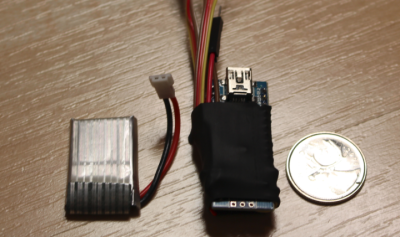There’s just something amazing about counting down and watching a rocket lift off the pad, soaring high into the sky. The excitement is multiplied when the rocket is one you built yourself. Amateur rocketry has been inspiring hackers and engineers for centuries. In the USA, modern amateur rocketry gained popularity after Sputnik-1, continuing on through the space race. Much of this history captured in the book Rocket Boys by Homer Hickam, which is well worth a read. This week’s Hacklet is dedicated to some of the best rocketry projects on Hackaday.io!
 We start with [Sagar] and Guided Rocket. [Sagar] is building a rocket with a self stabilization system. Many projects use articulated fins for this, and [Sagar] plans to add fins in the future, but he’s starting with an articulated rocket motor. The motor sits inside a gimbal, which allows it to tilt about 10 degrees in any direction. An Arduino is the brain of the system. The Arduino gathers data from a MPU6050 IMU sensor, then determines how to steer the rocket motor. Steering is accomplished with a couple of micro servos connected to the gimbal.
We start with [Sagar] and Guided Rocket. [Sagar] is building a rocket with a self stabilization system. Many projects use articulated fins for this, and [Sagar] plans to add fins in the future, but he’s starting with an articulated rocket motor. The motor sits inside a gimbal, which allows it to tilt about 10 degrees in any direction. An Arduino is the brain of the system. The Arduino gathers data from a MPU6050 IMU sensor, then determines how to steer the rocket motor. Steering is accomplished with a couple of micro servos connected to the gimbal.
 Next up is [Howie], with Homemade rocket engine. [Howie] is cooking some seriously hot stuff on his stove. Rocket candy to be precise, similar to the fuel [Homer Hickam] wrote about in Rocket Boys. This solid fuel is so named because one of the main ingredients is sugar. The other main ingredient is stump remover, or potassium nitrate. Everything is mixed and heated together on a skillet for about 30 minutes, then pushed into rocket engine tubes. It goes without saying that you shouldn’t try this one at home unless you’re really sure of what you’re doing!
Next up is [Howie], with Homemade rocket engine. [Howie] is cooking some seriously hot stuff on his stove. Rocket candy to be precise, similar to the fuel [Homer Hickam] wrote about in Rocket Boys. This solid fuel is so named because one of the main ingredients is sugar. The other main ingredient is stump remover, or potassium nitrate. Everything is mixed and heated together on a skillet for about 30 minutes, then pushed into rocket engine tubes. It goes without saying that you shouldn’t try this one at home unless you’re really sure of what you’re doing!
 Everyone wants to know how high their rocket went. [Vcazan] created AltiRocket to record acceleration and altitude data. AltiRocket also transmits the data to the ground via a radio link. An Arduino Nano keeps things light. A BMP108 barometric sensor captures pressure data, which is easily converted into altitude. Launch forces are captured by a 3 Axis accelerometer. A tiny LiPo battery provides power. The entire system is only 23 grams! [Vcazan] has already flown AltiRocket, collecting data from several flights earlier this summer.
Everyone wants to know how high their rocket went. [Vcazan] created AltiRocket to record acceleration and altitude data. AltiRocket also transmits the data to the ground via a radio link. An Arduino Nano keeps things light. A BMP108 barometric sensor captures pressure data, which is easily converted into altitude. Launch forces are captured by a 3 Axis accelerometer. A tiny LiPo battery provides power. The entire system is only 23 grams! [Vcazan] has already flown AltiRocket, collecting data from several flights earlier this summer.
 Finally we have [J. M. Hopkins] who is working on a huge project to do just about everything! High Power Experimental Rocket Platform includes designing and building everything from the rocket fuel, to the rocket itself, to a GPS guided parachute recovery system. [J. M. Hopkins] has already accomplished two of his goals, making his own fuel and testing nozzle designs. The electronics package to be included on the rocket is impressive, including a GPS, IMU, barometric, and temperature sensors. Data will be sent back to the ground by a 70cm transceiver. The ground station will use a high gain human-guided yagi tracking antenna with a low noise amplifier to pick up the signal.
Finally we have [J. M. Hopkins] who is working on a huge project to do just about everything! High Power Experimental Rocket Platform includes designing and building everything from the rocket fuel, to the rocket itself, to a GPS guided parachute recovery system. [J. M. Hopkins] has already accomplished two of his goals, making his own fuel and testing nozzle designs. The electronics package to be included on the rocket is impressive, including a GPS, IMU, barometric, and temperature sensors. Data will be sent back to the ground by a 70cm transceiver. The ground station will use a high gain human-guided yagi tracking antenna with a low noise amplifier to pick up the signal.
If you want more rocketry goodness, check out our brand new rocket project list! Rocket projects move fast, if I missed yours as it streaked by, don’t hesitate to drop me a message on Hackaday.io. That’s it for this week’s Hacklet, As always, see you next week. Same hack time, same hack channel, bringing you the best of Hackaday.io!
















Some relevant links
http://www.nakka-rocketry.net
http://www.tripoli.org
http://www.nar.org
and lastly the FAA airspace waiver (only required for class +2 rockets; >1500g net weight and/or 125g propellant)
http://www.faa.gov/documentLibrary/media/form/faa7711-2.pdf
When considering creating your own motors/propellant please be aware of ATF laws on low level explosive storage and manufacture. While it may still be hazy on sugar rocket mixtures being considered “potassium nitrate explosive mixtures” you want to be safe and responsible. Also check local ordinances at the city and state levels. When testing motors be safe and assume that will all explode. Attention to detail and strict record keeping is a must in this hobby.
I suggest if getting into larger rockets to also get into a local club due to the wealth of knowledge in both rocketry and the laws/paperwork in your area necessary for these larger scale launches.
Wow. The guided rocket project is extremely irresponsible. If that dude is in the US he’s in for a visit if not jail time… and I would personally not have a problem with either. I considered the “3D printed gun” crap to be childish but at least not all that particularly dangerous except in how they seemed to actively encourage and revel in the resulting mindless media panic. I’m glad not a whole lot came of that, as far as dumbass laws go. This is different. People ARE actually using hobbyist electronics sites for instruction on making bombs and things. Generally, the knowledge is general purpose and as such there’s really not much you could/should do about it (besides cooperate with law enforcement or at least not go out of your way to hinder any investigation). This doesn’t cross the line it blows right past it. Just because something is interesting (yes, even cool, in a way) doesn’t mean you need to build it. It certainly doesn’t mean your entitled to do whatever reckless dumbass thing you want. I’m quite sure his project violates multiple parts of CFR 121.1 IV, INCLUDING the software. Hackaday by providing a project page is in dangerous waters and needs to shut down the project page and step away before they get in some serious trouble. Or to put all this another way… Guided rockets?!? Seriously?!? WTF are you thinking?
Look back in the archives… This isn’t the first time somebody ended up on HaD with a guided rocket project…
Well, the project link appears dead for the old one. I think it’s maybe possible for a hobbyist to build this stuff legally (I have no idea, not a lawyer, don’t quote me) but freely sharing info on how to do it is very very likely not legal… if you’re in the US at least. I see the “Arduino Space Program” is in the UK, so different story.
Obviously commercial entities do vectored thrust, so there must be a legal framework to do that through (which may include permits, background checks for those involved, who knows). I don’t see SpaceX sharing plans on how to make that with the world, though.
And in the UK having these “chemicals” and mixing them in such a manner could be considered to be an explosive. It’s down to the judge and jury to decide if you have a legitimate use for them or not.
Having a leatherman on your person is a risky business in the UK. It’s either an illegal weapon or a tool. Depending on whom is trying to convict you and your ability to convince the magistrate.
After another check on the site, I did find the previous project page. (The direct link is broken). I see a description of what they did, not instructions. Sharing what you did is quite a bit different than sharing how to build your own.
I think that there is a big difference between active stabilization and aiming a rocket at a target as a weapon. Of course there is still ITAR limitations on this kind of technology, but nothing illegal from what I see in displaying a project description (obligatory not a lawyer etc). Guidance doesn’t make something a weapon, a warhead does.
But then again you could easily create a “weapon” on a normal rocket by adding explosives and aiming it at a target. A living room lamp can be considered a weapon, but intent is everything there. If using active stabilization is used to explore that technology and make your rocket more safe (vectored thrust to control ballistic flight paths) I don’t see a problem (besides giving step by step instructions ITAR blah blah), but even then, to other US citizens, free game.
But even setting everything here aside, the thrust vector rocket project seems to have quite a few engineering problems. First off, rocket motors for the size of his project are all fast burning 1-3 seconds. It’s hard to adjust vectors fast enough to obtain reliable flights in just 3 seconds with such static accelerations under foot. Thrust vectoring also only works during powered flight, you still need to coast and need to be aerodynamic during this stage. The vectoring mechanism is directly attached to the servos (all sorts of issues there) with way too much movement allowed. It needs to be geared down for torque and fine adjustment. I never see that project working without a compete redesign. Let alone seeing an RSO permitting it to fly under their waiver.
I think the main problem is not that he did it, but that he’s trying to show everyone and anyone how to do it.
He states on the project page that: “Most guided rocket technology is restricted to the military, so I am going to try to make this open source and replicable by anyone.” So, I think the vertical guidance was just a step. Looking at what appears to be his youtube page he seems to be a bit on the crazy side of libertarianism. It looks like pushing against authority is a thing for him. Being 17 or so, that’s maybe only natural.
The project is actually old, and it looks like he’s moved on. So, that’s good.
I think hackaday should drop the project page. Age doesn’t guarantee it won’t turn into a problem. Reporting on something is one thing, providing a how-to is quite another.
Gotcha
Heh. You can buy a machine gun in US, but god forbid anyone from flying model rockets. Goddard would cry.
It’s very important to not get bubbles in your homebrew solid rocket fuel. They can do things like swell up from the heat and choke off the burn channel. Fuel keeps burning above the choke and *boom*. Another bad thing is when a bubble gets burned into it can cause turbulence in the combustion and can burn faster there, burning through the motor casing. That’s not a good thing for a rocket.